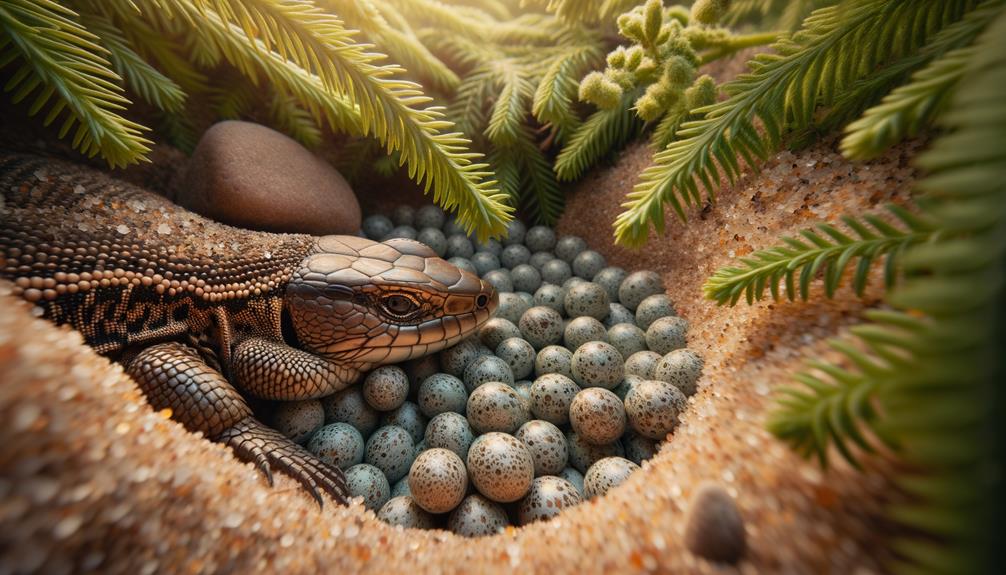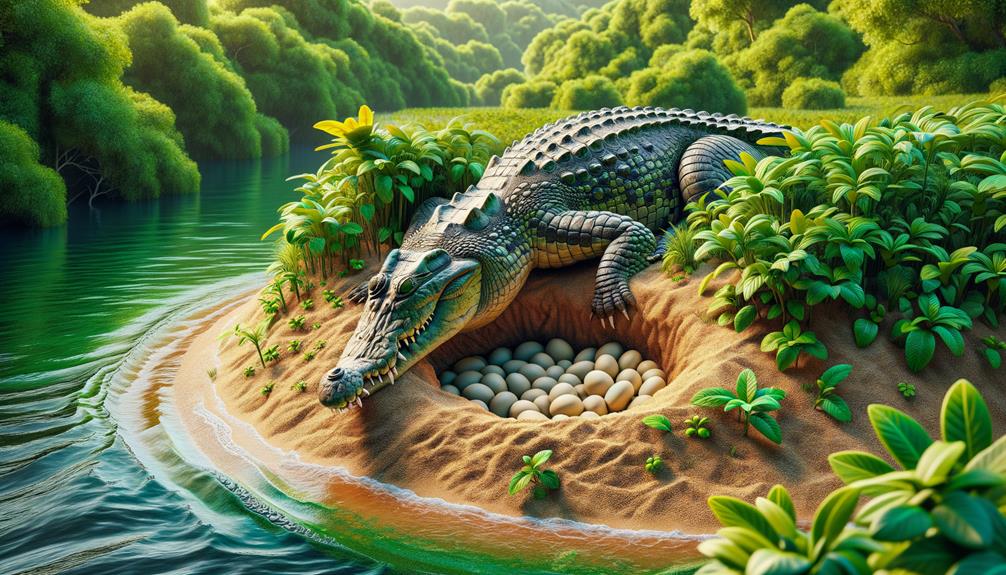Reptile egg-laying is a fascinating process with plenty of variety. Take ball pythons, for example. These snakes coil around their eggs to keep them warm. Corn snakes, on the other hand, opt for a more hands-off approach, using materials like loose soil to insulate their clutches.
Lizards have their own tricks. Common iguanas dig deep holes for their eggs, while some skinks stick around to guard their precious cargo. Sea turtles make the long journey to shore, burying their eggs in sandy nests. Crocodiles mix things up, creating nests filled with organic matter near water sources.
These behaviors showcase how adaptable reptiles can be. From king cobras laying massive clutches to turtles whose offspring's sex is determined by nest temperature, each species has its own survival strategy.
Despite the challenges Mother Nature throws their way, reptiles have developed clever methods to ensure their young have the best shot at life. Their diverse approaches to egg-laying and nest-building are just one example of how these creatures have thrived for millions of years.
Snake Egg Laying Patterns
Snake egg-laying habits vary widely across species, reflecting their unique adaptations to different environments. Take the ball python, for example. These snakes prefer secluded, damp spots for laying eggs, and often wrap themselves around their clutch to maintain the right temperature. It's a fascinating behavior that shows how involved some snake species are in caring for their offspring.
On the other hand, corn snakes opt for loose soil or fallen leaves to nest. This natural cushioning protects their eggs and provides insulation. The number of eggs laid can differ dramatically between species. A king cobra might produce up to 40 eggs in a single clutch, while a smaller species like the milk snake typically lays around 10. These differences reflect each species' survival strategy and the resources available in their habitat.
I once spotted a garter snake laying eggs in my garden. It had chosen a spot with just the right balance of sun and moisture, showcasing these reptiles' knack for finding suitable nesting sites. Incubation times also vary considerably, from a few weeks to several months, depending on the species and environmental conditions. This diversity in reproductive strategies underscores the remarkable adaptability of snakes to their surroundings.
Lizard Nesting Behaviors

Lizards have some pretty cool ways of nesting. Take the common iguana, for instance. These guys are like tiny excavators, using all four limbs to dig deep holes for their eggs. It's impressive how they create these underground nurseries that keep the eggs safe and at just the right temperature.
But not all lizards are so hands-on. Many species just lay their eggs and take off, leaving the little ones to figure things out on their own from day one. It's a tough world out there for baby lizards!
On the flip side, some lizard parents are real homebodies. Certain species wrap themselves around their eggs like living blankets, standing guard until the babies hatch. Talk about dedication!
Let's break down how different lizards handle their nesting:
| Species | Nesting Style |
|---|---|
| Common Iguana | Digs deep holes |
| Gecko | Lays eggs and leaves |
| Skink | Wraps around eggs for protection |
| Anole | Hides eggs in secret spots |
| Monitor Lizard | Makes long underground tunnels |
These varied approaches show how lizards have adapted to all sorts of environments. Whether it's digging, hiding, or guarding, each species has found its own way to give its offspring a fighting chance.
Turtle Egg Deposition

Turtles laying eggs is a remarkable sight that reveals the ingenuity of these ancient creatures. As a frequent observer, I've noticed each species has its own unique approach. Under the night sky, female turtles come ashore, often returning to their birthplaces to nest.
The process is methodical. Using their back flippers, turtles dig a hole for their eggs. Once ready, they deposit their clutch. Here's what happens next:
- Egg Laying: The female releases her eggs, with numbers varying widely between species.
- Hiding the Nest: After laying, turtles cover their eggs with sand to shield them from danger.
- Waiting Period: The eggs develop over weeks or months, with temperature influencing whether hatchlings will be male or female.
Watching this age-old routine always strikes me. It's a testament to these creatures' resilience and precision, giving their offspring a chance at life.
Crocodile Nest Construction

Watching crocodiles build their nests offers a glimpse into the remarkable mix of instinct and planning these powerful reptiles possess. Female crocodiles carefully choose secluded spots near water, often picking areas with just the right moisture levels for their eggs.
The process kicks off with the female digging a hole, sometimes as deep as a meter. She scrapes out soil and plants, crafting a safe space for her future offspring. This job can take hours, showing off her persistence and attention to detail. Once she's satisfied, she lays her eggs – anywhere from 20 to 60, depending on the species.
After laying, she covers the eggs with a blend of dirt and plant matter. This clever move not only hides them from hungry predators but also keeps the temperature and humidity just right. Throughout this time, the mother croc stays on high alert, often sticking close by to ward off any threats.
Seeing this intricate process unfold, it's hard not to be impressed by how well these ancient creatures understand their surroundings and the lengths they go to ensure their babies have the best shot at survival.
Conservation and Human Interaction

Safeguarding reptile nesting sites plays a key role in preserving biodiversity. Human activities, like destroying habitats and polluting environments, pose direct threats to successful reptile reproduction. I've noticed that when we damage natural areas, more reptile eggs fail to hatch.
Setting up nature reserves helps protect habitats, giving reptiles safe places to lay eggs without interruption. These protected zones have made a big difference in keeping species alive.
For endangered reptiles, targeted breeding programs can boost population numbers. These often involve carefully incubating eggs in controlled environments before releasing the young into the wild, improving their chances of survival.
Raising public awareness about reptiles and their nesting sites can encourage people to live alongside these creatures. Informational campaigns can reduce human interference and promote actions that support conservation.
I once visited a beach where coastal erosion had wiped out turtle nesting grounds. By pushing for habitat protection and cutting down on pollution, we can help ensure reptile eggs and hatchlings survive. When we interact responsibly with nature, we help reptiles continue to thrive, maintaining the careful balance in our ecosystems.
Frequently Asked Questions
What Are Some Facts About Reptile Eggs?
Reptile eggs come in a range of textures, from soft and pliable to hard and brittle. I once watched a sea turtle on a sandy shore, laying eggs with a consistency akin to leather. It was a striking example of how nature adapts to different environments. In some reptile species, the temperature during incubation actually determines whether the offspring will be male or female – a remarkable quirk of evolution that scientists are still studying closely.
How Do Reptiles Lay Eggs?
Reptiles have a fascinating approach to laying eggs. They're quite particular about it, really. These creatures search for just the right spot – somewhere warm and cozy. They might dig a hole or find a little nook, all to make sure their eggs have the best chance at hatching. It's pretty interesting how some, like turtles, will go back to the same nesting spots year after year. It's almost like they have a favorite vacation spot, but for egg-laying!
How Long Does It Take for a Reptile Egg to Hatch?
Reptile egg incubation varies widely across species. Smaller reptiles like geckos typically hatch in about one to two months, while larger creatures such as crocodiles may take two to four months. These timelines aren't set in stone, though. Environmental factors, particularly temperature and humidity, play a significant role in determining how long it takes for a baby reptile to emerge from its egg. The specific conditions required for successful incubation differ from species to species, making the hatching process a fascinating aspect of reptile biology to observe and study.
What Are 5 Facts About Reptiles?
Reptiles showcase a range of fascinating reproductive methods, from egg-laying to giving birth to live young. In many species, the temperature during incubation determines whether the offspring will be male or female. These cold-blooded creatures thrive in diverse habitats, from deserts to rainforests, thanks to their unique adaptations. Some lizards can regrow their tails if they lose them, a handy trick for escaping predators. The evolutionary journey of reptiles spans millions of years, offering a wealth of information about how life on Earth has changed over time.



